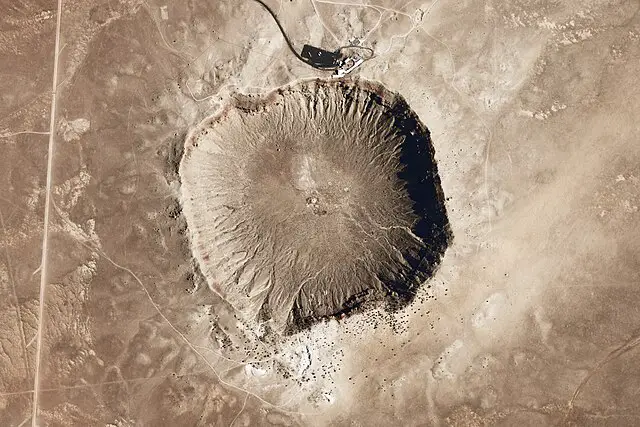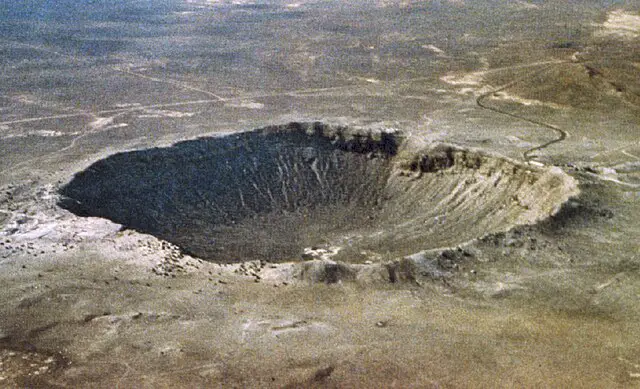In the heart of the Arizona desert, beneath the scorching sun, lies an enormous wound carved into the Earth’s surface. At first glance, it looks like a barren pit—a place where nothing significant happens. But this crater is far from ordinary. It’s a silent witness to one of the most violent events in our planet’s history, a reminder that Earth is not immune to cosmic threats.
Around 50,000 years ago, a fireball blazed through the atmosphere, hurtling toward what would one day become the American Southwest. It was only about the size of a small building, but it carried the destructive power of 10 million tons of TNT. In mere seconds, it collided with the Earth, releasing energy equivalent to 150 Hiroshima bombs and leaving behind a scar nearly 4,000 feet wide and 600 feet deep. This is Meteor Crater—the best-preserved impact site on our planet and an unparalleled gateway into Earth’s celestial history.
What Exactly Is Meteor Crater?
Meteor Crater, also known as Barringer Crater, is a gigantic hole in the ground—but not just any hole. Measuring 3,900 feet (1,200 meters) across and 560 feet (170 meters) deep, it’s the result of a nickel-iron meteorite traveling at an estimated 26,000 mph (42,000 km/h) before slamming into what is now the Arizona desert.
What’s even more mind-blowing? The meteorite that caused this devastation was likely no bigger than 160 feet (50 meters) wide—about the size of a small apartment building. Yet, its impact unleashed the energy equivalent of a 10-megaton explosion, reshaping the land in an instant. This event left behind a perfectly preserved impact site, making Meteor Crater one of the most studied craters in the world.

A Scientific Playground for Space Exploration
Meteor Crater isn’t just a tourist attraction—it’s a training ground for astronauts and a window into Earth’s violent past. During the Apollo program, NASA sent astronauts here to prepare for the Moon landings. The crater’s terrain, with its rugged landscape and scattered debris, closely resembled the lunar surface, providing an ideal testing ground for moonwalks and geology studies.
Even today, researchers study Meteor Crater to understand impact events across our solar system. By analyzing the layers of rock ejected from the crater, scientists can unravel the mysteries of ancient asteroid impacts and what they could mean for Earth’s future.
What Would Happen If It Hit Today?
A meteor impact of this magnitude in today’s world would be devastating. If a similar-sized space rock struck near a major city, the explosion would flatten buildings, generate massive shockwaves, and create an impact winter—a period of global cooling caused by debris blocking out the sun. While Earth’s atmosphere burns up most small meteors before they reach the surface, larger ones still pose a real threat. That’s why scientists closely monitor near-Earth objects, tracking their paths to prevent potential future disasters.
Visiting the Crater: A Step Into Earth’s Violent History
Today, Meteor Crater is one of Arizona’s most fascinating attractions. Visitors can walk along the rim, take guided tours, and even stand on observation decks that offer a jaw-dropping view of the impact site. The Meteor Crater Visitor Center features exhibits, interactive displays, and even fragments of the meteorite itself.
For thrill-seekers and science lovers alike, standing at the edge of this colossal crater is a humbling reminder of the raw power of the universe. It’s a place where you can see, touch, and truly feel the effects of an event that shaped Earth’s history—an event that, given the right circumstances, could happen again.
The Takeaway: A Cosmic Wake-Up Call
Meteor Crater is more than just a giant hole in the ground—it’s a warning, a wonder, and a scientific treasure. It tells the story of a world-changing event, reveals secrets about our planet’s past, and reminds us that Earth is still vulnerable to impacts from space. As we continue to explore the cosmos, Meteor Crater stands as a silent testament to the power of the universe—a force that, at any moment, could rewrite the story of life on Earth once again.

